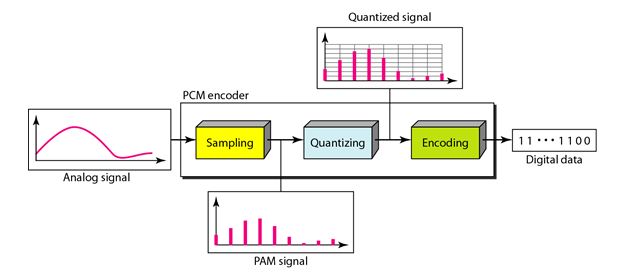Techniques of analog-to-digital Conversion

Analog-to-digital conversion (ADC) is the process of converting continuous analog signals into discrete digital representations. This conversion is essential in various applications, including communication systems, audio processing, instrumentation, and data acquisition. There are different techniques employed for analog-to-digital conversion, each with its own advantages and trade-offs. Here are some common techniques:
-
Successive Approximation ADC:
- This is a popular and widely used technique.
- It operates by successively comparing the input signal to a reference voltage and determining the most significant bit (MSB) first, then the next bit, and so on.
- The process continues until the digital representation is within a specified tolerance of the analog input.
-
Flash ADC (Parallel ADC):
- Flash ADCs are fast and operate in parallel.
- They use a series of comparators to compare the input voltage to multiple reference voltages simultaneously.
- The outputs of these comparators are then encoded to provide a digital representation of the input voltage.
- Flash ADCs are fast but can be complex and power-hungry, especially for higher resolutions.
-
Delta-Sigma (ΔΣ) ADC:
- Delta-sigma ADCs use oversampling and noise shaping techniques to achieve high resolution.
- The input signal is oversampled at a much higher rate than the Nyquist rate, and a digital filter is used to shape the quantization noise.
- Delta-sigma ADCs are often used in applications where high resolution and precision are critical, such as audio applications.
-
Pipeline ADC:
- Pipeline ADCs use a series of stages (pipelines) to process the input signal.
- Each stage performs part of the analog-to-digital conversion process, and the results are passed through the pipeline.
- Pipeline ADCs are known for their speed and are suitable for applications where high-speed conversion is required.
-
Dual-Slope ADC:
- Dual-slope ADCs use a capacitor to integrate the input signal for a fixed period and then discharge it for a variable period.
- The conversion time is determined by the time it takes for the capacitor to discharge.
- Dual-slope ADCs are often used in applications where accuracy is more critical than speed.
-
Time-Interleaved ADC:
- Time-interleaved ADCs use multiple ADC channels operating in parallel but with a time offset.
- This technique is used to achieve higher sampling rates by interleaving the output of multiple lower-speed ADCs.
- Time-interleaved ADCs are commonly used in high-speed communication systems.
The choice of an ADC technique depends on factors such as the required resolution, speed, power consumption, and the specific application's constraints. Each technique has its advantages and limitations, and designers select the most suitable one based on the application's requirements and trade-offs.
Thank you.